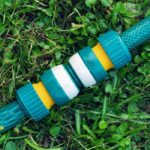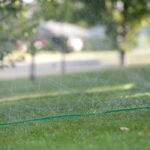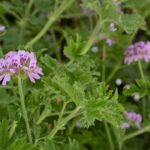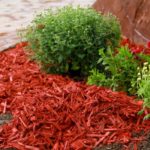Although the lucky bamboo plants may look and grow like the outdoor bamboo plant, the two plants aren’t related at all. In fact, lucky bamboo is more of a succulent. Ideal for good feng shui, it’s adorned with small, floppy green leaves and can be trained to grow completely straight. But how should you care for your household bamboo plant?
The best way to care for lucky bamboo plants is by ensuring they’re watered properly. Make sure you add at least an inch of bottled or filtered water every week or when the soil feels dry to the touch. Place the plant under bright, indirect sunlight and in temperatures between 65˚F and 90˚F.
If you follow these basic care tips, you should be able to foster a happy, healthy bamboo plant. Let’s take a closer look at how often bamboo plants need to be watered, whether they grow best in soil or water, and in which environments they thrive.
How Often Do Bamboo Plants Need to Be Watered?

Bamboo plants thrive when they receive at least an inch of water every week. Make sure you water the plant deeply, as it helps encourage deep roots and protects the bamboo from drought.
If you’ve planted your lucky bamboo stalks (on Amazon) in soil, make sure the container or pot has good drainage. While the plant loves moist soil, overwatering it can negatively affect its growth. For this reason, it’s best to add water only when the top inch of soil feels dry to the touch.
Keep in mind that lucky bamboo doesn’t tolerate chlorine, so adding regular tap water will turn its leaf tips brown and eventually kill the plant. Instead, it’s advisable to use bottled or filtered water to achieve the best results. Alternatively, you can just let a glass of tap water stand on the kitchen counter overnight before using it to water your plant.
If you’ve planted the bamboo in a water vase, make sure you change the water every week to avoid odors and diseases. It’s also important to ensure that the roots are completely submerged in water at all times.
Add some water after every two to seven days, adjusting the quantity as needed. It’s best to completely change the water in the vase every one to three months as well, or more frequently if the water starts giving off a weird smell.
Lucky Bamboo vs. Regular Bamboo
Lucky bamboo, or Dracaena sanderiana, is an incredibly common houseplant that you can grow in both soil and water. While its stalks look very similar to those of a regular bamboo plant, lucky bamboo actually belongs to the Asparagaceae family.
It’s also deeply rooted in feng shui — an ancient Chinese ideology that dates all the way back to ninth-century BC — and is traditionally gifted to promote good fortune, health, good luck, growth, and love.
While regular bamboo has sturdy, wood-like stems, lucky bamboo sprouts softer, fleshy stems. Nonetheless, it grows almost as quickly as regular bamboo and can reach heights of up to 19 inches in only six months.
Lucky bamboo can grow up to 39 inches tall and its pale green leaves can measure nine inches long. Its stems can grow in a curly, braided, or straight manner, and professional gardeners can even train the stems to grow into wonderfully unique shapes.
What Are the Signs a Bamboo Plant Needs to Be Watered?
Although the lucky bamboo plant is incredibly easy to grow and maintain, there are a few things you should look out for. The first and most important thing you should do is check the soil. Try to wiggle your finger a few inches into the soil to get a rough idea of how moist or dry it is. If you can’t find any moisture at three or four inches, water your bamboo plant.
But if you’ve covered your lucky bamboo with a lot of mulch or just don’t like getting your fingers dirty, here are a few other signs of a thirsty plant to keep an eye out for:
Curling Leaves
If you’ve under-watered your lucky bamboo plant, its leaves will start to curl in on themselves. However, it’s important to note that intense sunlight can also cause curling leaves at times. For this reason, it’s best to double-check your plant’s leaves after the sun goes down, when they’re no longer under direct sunlight.
Waterlogged soil can also result in curling leaves, so make sure you confirm that’s not the case before adding more water.
Brown Leaf Tips
The tips of your bamboo plant’s leaves will turn brown if it receives too much heat or not enough water. But keep in mind that browning can also happen because of over-watering. Make sure you consider the weather and the last time you watered the plant and then adjust accordingly.
If the weather’s been extremely hot and dry, water your lucky bamboo plant. You can also remove all affected leaves using a sharp, sterile pair of scissors.
On the other hand, if the weather’s been fairly mild and you’ve been watering the plant regularly, cut off the water for a week and then see what happens.
Should You Keep Bamboo in Soil or Water?
While lucky bamboo can survive in both soil and water, planting it in soil will ensure it lives longer, assuming you prevent the soil from completely drying out. However, this doesn’t mean that you can’t keep it in water.
In fact, lucky bamboo can thrive in a water vase as well, as long as its roots are submerged in at least an inch of water at all times. For the best results, make sure you change the water every week and clean the vase thoroughly if you see any algae in the water.
What Environment Does Bamboo Grow Best In?
Lucky bamboo grows best indoors, especially when it’s kept in a warm, well-lit room. While you can plant it in your garden outside, harsh sunlight and cold temperatures will ultimately damage it.
To help ensure your lucky bamboo thrives for as long as possible, here are a few other factors you should keep an eye out for:
Light
Lucky bamboo plants thrive when they receive bright, indirect sunlight. Try to avoid placing your plant under direct sunlight, as the harsh sun might damage and burn its delicate leaves. If your plant’s leaves start turning yellow, then it may be a sign that the bamboo is receiving too much sun.
Medium-direct sunlight also works for this indoor plant. Lucky bamboo grows in low-light conditions as well, making it an excellent addition to shady offices or corners that don’t get a lot of natural light.
Humidity and Temperature
As you might have guessed, lucky bamboo plants love warmer temperatures, preferably those that range from 65˚F to 90˚F. Make sure you don’t place the plant anywhere close to a draft (cold or hot) or in front of a heating vent or air conditioner.
When it comes to humidity, the plant does fine in average humidity, so you don’t need to worry about increasing it in your home.
Fertilizer
Adding only a drop of liquid fertilizer (on Amazon) every month is more than enough for most lucky bamboo plants. However, specialty lucky bamboo fertilizers are also available, if you prefer to use them instead.
If you’ve planted your lucky bamboo in water, then you’ll only need to add a few drops of weak liquid fertilizer every other month or so. Remember that the roots of a healthy lucky bamboo plant turn red, so don’t worry if you notice red roots in your glass vase.
Container

When you receive or purchase a lucky bamboo plant, it usually has its own container that’s often topped with beads or pebbles. If your plant outgrows the original container, then you’ll need to move it to another larger container that can hold it.
Gently dig up your bamboo plant, transfer it to its new pot, and then carefully rebury its roots under the pebbles, ensuring they’re completely covered. Also, make sure you add as much water as needed to submerge the roots, but not so much that it wets the stalks.








